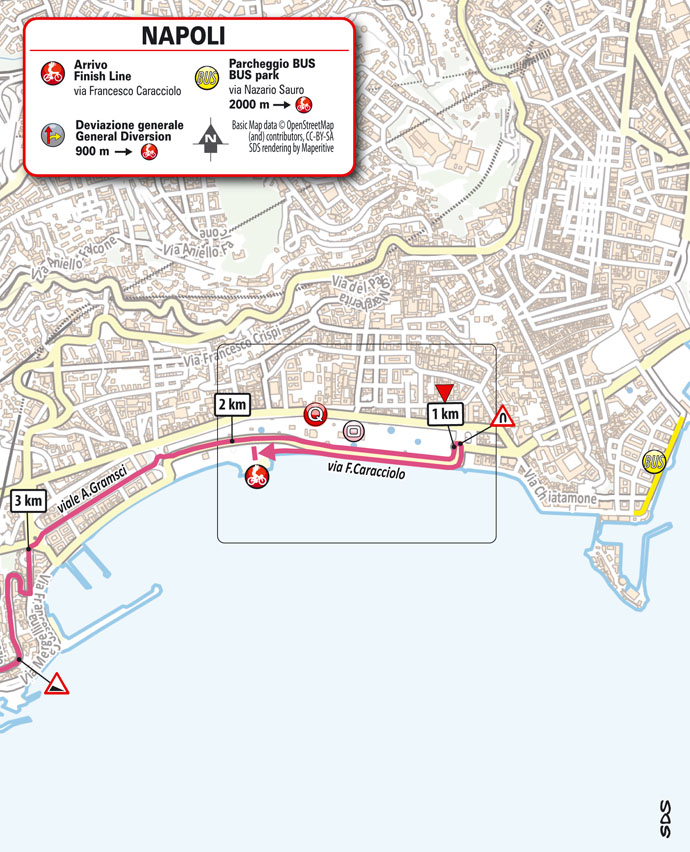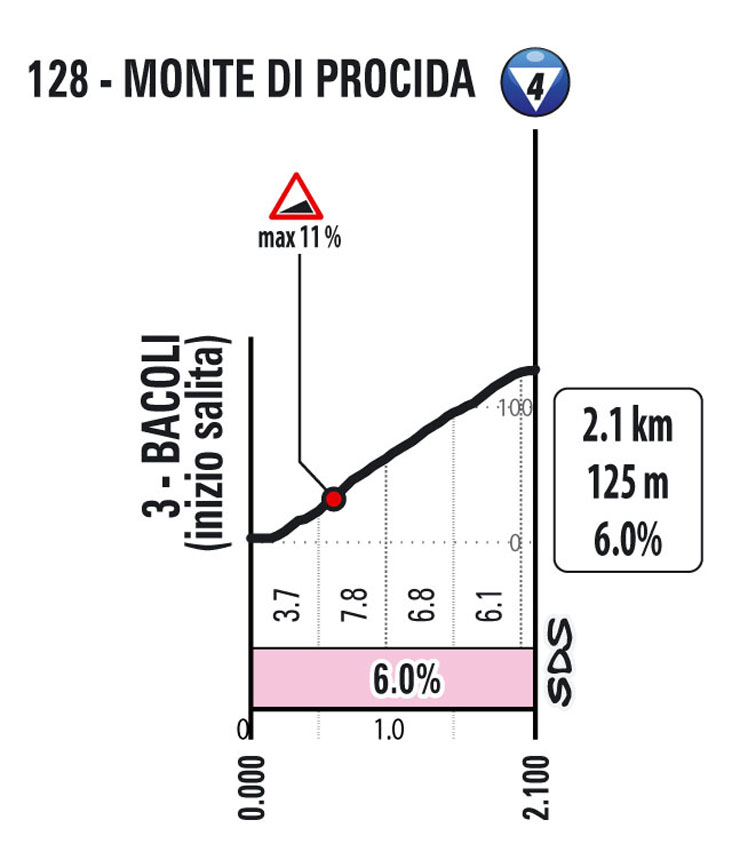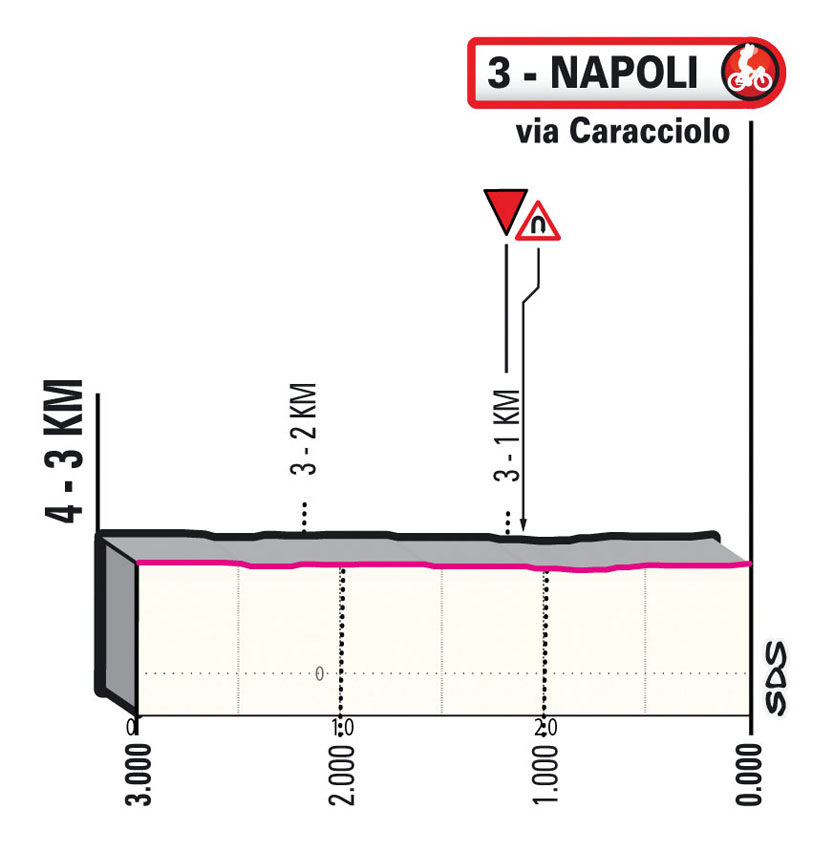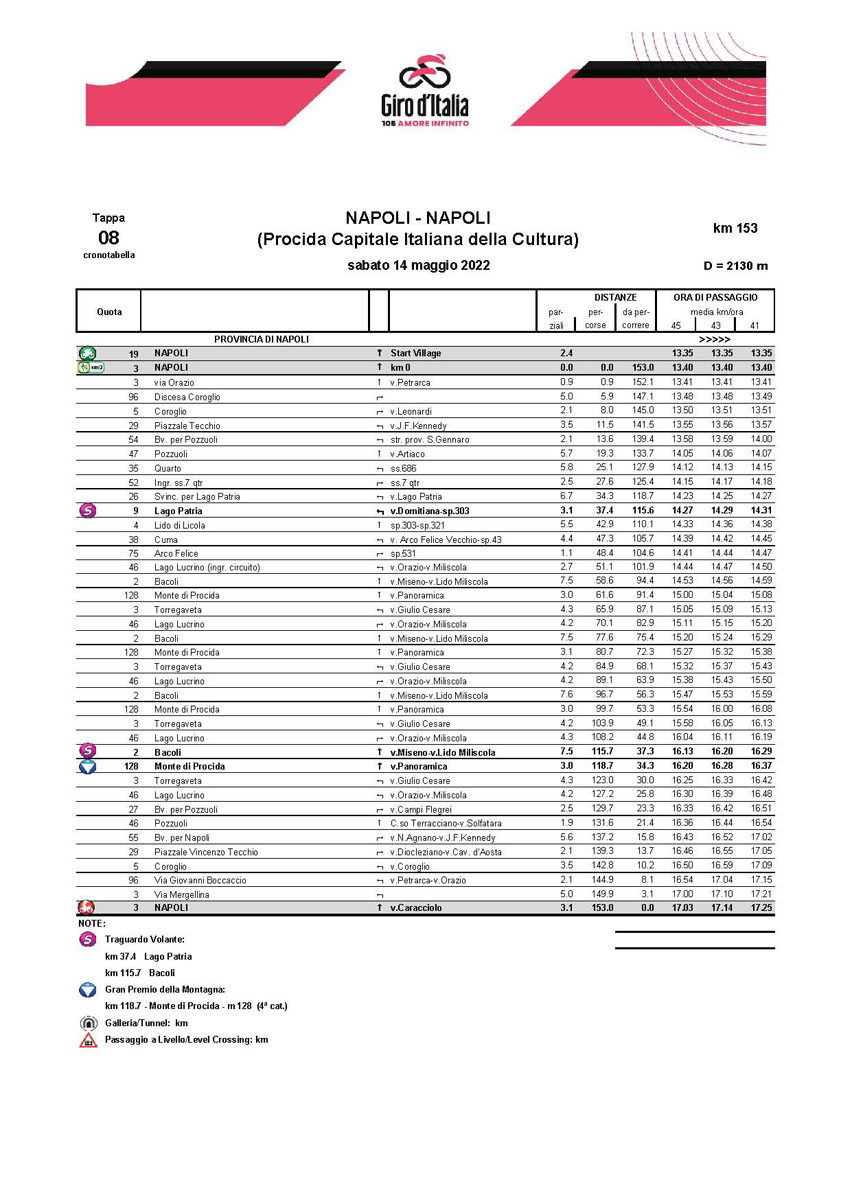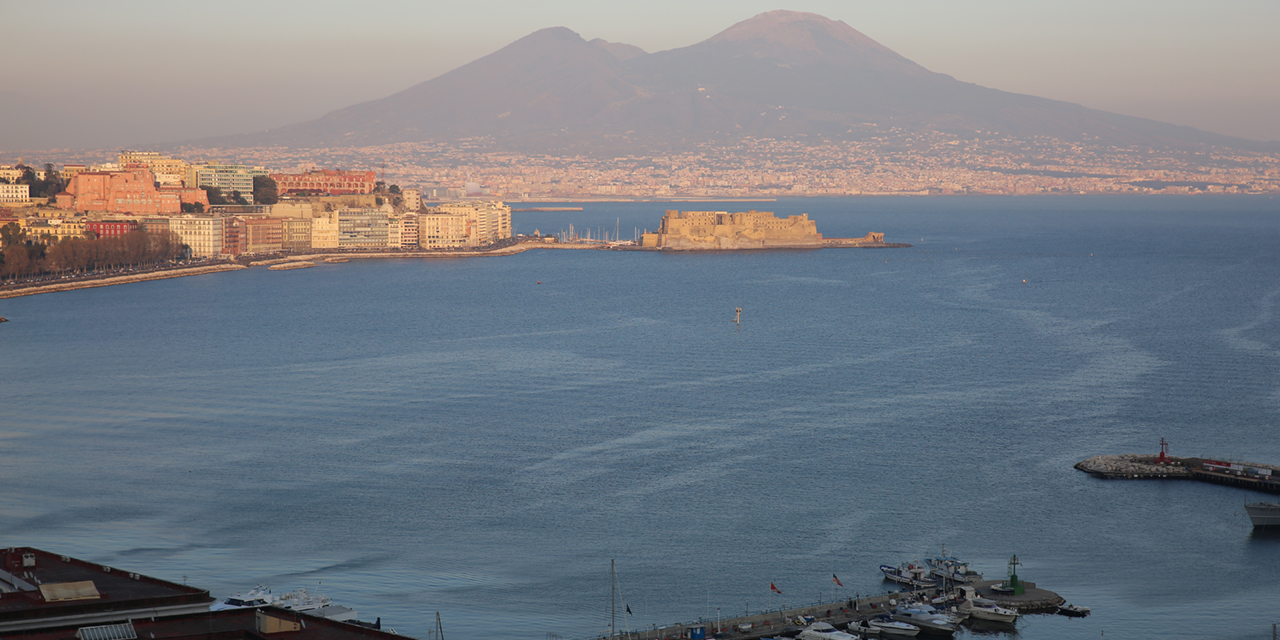profile
map
technical info
The route
This challenging and intense stage, raced entirely on urban roads, sets off passing over the finish line. The route climbs up the Posillipo hill, heading to Bacoli and taking a loop along the coast. Past Bacoli, the riders will cover the Monte di Procida circuit (19 km) four times. The roads here are well surfaced but narrow, with a succession of bends and constantly changing gradients. Past Torregaveta, in Baia, the route kicks up at a 14% gradient to Lago Lucino, where the riders will leave the circuit at the end of the last lap. The route goes back to Bacoli and Posillipo along the same route, with a long descent down the Via Petrarca leading to the final kilometres in the city centre.
Final kilometres
The last 3 pan-flat kilometres run eastwards along the Via Dohrn and Via Caracciolo. At the last km, the route takes a U‑turn at a roundabout, and returns along the Via Caracciolo all the way to the finish. The home straight (900 m) is on tarmac.
start / finish
climb detail
final kilometres
itinerary timetable
tourist info
Host city:
Napoli
Touristic information
The age-old history of Naples goes back to the first Greek colonies in the area of modern-day Castel dell’Ovo. The settlers later founded a new city, nea polis in Greek, which is where the place name Napoli comes from.
The city long retained its Greek values and mores even after being taken over by the Romans, under whom it became a major cultural pole. Naples grew into a grandiose, majestic city over the centuries, under different prominent rulers, reaching all the way to the surrounding hills.
Naples holds a remarkable historical and artistic heritage, and an endless cultural legacy, in a stunningly beautiful natural setting at the foot of the Vesuvio, overlooking the sea. Much was written in travel journals of all times about the balanced and harmonising combination of nature and culture, and visitors today will surely be impressed as well.
Gastronomy
The visitor who arrives in Naples will be attracted not only by art and landscape, but he will also appreciate the local gastronomy which is rich and variegated.
Generally, the use of french words for neapolitan food is impressive. For instance gâteau, made with potatoes or the famous meat ragoût, croquets also made with potatoes, are just some examples. The reason is that once the rich neapolitan families used to have in their houses french chefs called monzù (from the french word monsieur) that introduced french terms into the neapolitan gastronomic culture. The most famous food is pizza. According to the tradition it was prepared for the first time by the end of the XIXth century in honour of Margherita of Savoy, queen of Italy. So the most important version of pizza with tomatoes, basil and mozzarella is called Margherita. In the city centre people use to eat in the street the so-called “pizza a portafoglio”, a small pizza fold as a “wallet”, as well as the “pizza fritta” fried into hot oil.
Concerning the local bakery “pastiera” is very appreciated. It is filled with wheat, ricotta cheese, sugar and eggs and it is the typical Easter cake. But it is also eaten during the whole year as well as babà and sfogliatelle, typical of the local bakery too.
Beverages
Coffee is one of the symbols of Naples. Appreciated for its restoring property it is more than a simple beverage. Offering a cup of coffee or simply drinking it has a symbolic value, it’s a kindness, it’s an act of friendship. Coffee is an opportunity for shortening distances and engaging a conversation. In Naples there is the custom of “caffè sospeso”: when you take a coffee in a bar you can pay for an other coffee than is destinated to an other customer who will ask for. In this way is offered to a person who can not afford the price of the coffee.
Although it is appreciated in all its varyties the most traditional manner to prepare the coffee is using the so-called “cuccuma” the typical neapolitan coffee maker. It’ is composed of two overlapped containers. One is fill up with water and the other one with coffee powder. When the water boils, it is necessary to overtun the coffee maker in order to make water filter through the coffee powder. During this procedure it’s better to cover the spout of the coffee maker with a “coppettiello” that is a piece of paper fold as a cone in order to preserve the coffee aroma. It is taught by Eduardo De Filippo in his famous comedy “Questi fantasmi”.
Main sights
In 1995 the historical centre of Naples entered in the UNESCO world heritage list. It’s a huge and heterogeneous territory that involves different districts and it testifies the long history of the town.
In particular, the city center, that corresponds to the ancient Neapolis, with its long and narrows streets still keeps the typical and regular urbanistic structure of the greek and roman cities that is similar to a chessboard. Buildings of the Roman Empire are visible too, expecially the ruins of a theater and a market. Then, there also are stratifications of different ages that have seen the succession of various people and cultures. For exemple there are many medieval and baroque churches that keep a lot of valuable works of art.
Among the most important cultural sites there is the National Archeological Museum that is a landmark for ancient art. Here there are the finds coming from Pompeii and Herculaneum. An other important museum is Capodimonte, surrounded by the homonymous wood, where a rich artistic collection from Middle Ages to nowadays is exposed.
The underground city is very interesting too. It is possible to visit ancient tufa quarries that in the past where used as cisterns and also as shelters during the Second World War.
People who arrive in Naples have also to visit the hill districts. In Vomero it is possible to see the Charterhouse of San Martino or the XVth century Castle of Sant Elmo from which is possible to admire the city from above. Another panoramic point of the city is the hill of Posillipo. From here tourists can appreciate the Gulf of Naples and Sorrento coast.
Napoli
Touristic information
The age-old history of Naples goes back to the first Greek colonies in the area of modern-day Castel dell’Ovo. The settlers later founded a new city, nea polis in Greek, which is where the place name Napoli comes from.
The city long retained its Greek values and mores even after being taken over by the Romans, under whom it became a major cultural pole. Naples grew into a grandiose, majestic city over the centuries, under different prominent rulers, reaching all the way to the surrounding hills.
Naples holds a remarkable historical and artistic heritage, and an endless cultural legacy, in a stunningly beautiful natural setting at the foot of the Vesuvio, overlooking the sea. Much was written in travel journals of all times about the balanced and harmonising combination of nature and culture, and visitors today will surely be impressed as well.
Gastronomy
The visitor who arrives in Naples will be attracted not only by art and landscape, but he will also appreciate the local gastronomy which is rich and variegated.
Generally, the use of french words for neapolitan food is impressive. For instance gâteau, made with potatoes or the famous meat ragoût, croquets also made with potatoes, are just some examples. The reason is that once the rich neapolitan families used to have in their houses french chefs called monzù (from the french word monsieur) that introduced french terms into the neapolitan gastronomic culture. The most famous food is pizza. According to the tradition it was prepared for the first time by the end of the XIXth century in honour of Margherita of Savoy, queen of Italy. So the most important version of pizza with tomatoes, basil and mozzarella is called Margherita. In the city centre people use to eat in the street the so-called “pizza a portafoglio”, a small pizza fold as a “wallet”, as well as the “pizza fritta” fried into hot oil.
Concerning the local bakery “pastiera” is very appreciated. It is filled with wheat, ricotta cheese, sugar and eggs and it is the typical Easter cake. But it is also eaten during the whole year as well as babà and sfogliatelle, typical of the local bakery too.
Beverages
Coffee is one of the symbols of Naples. Appreciated for its restoring property it is more than a simple beverage. Offering a cup of coffee or simply drinking it has a symbolic value, it’s a kindness, it’s an act of friendship. Coffee is an opportunity for shortening distances and engaging a conversation. In Naples there is the custom of “caffè sospeso”: when you take a coffee in a bar you can pay for an other coffee than is destinated to an other customer who will ask for. In this way is offered to a person who can not afford the price of the coffee.
Although it is appreciated in all its varyties the most traditional manner to prepare the coffee is using the so-called “cuccuma” the typical neapolitan coffee maker. It’ is composed of two overlapped containers. One is fill up with water and the other one with coffee powder. When the water boils, it is necessary to overtun the coffee maker in order to make water filter through the coffee powder. During this procedure it’s better to cover the spout of the coffee maker with a “coppettiello” that is a piece of paper fold as a cone in order to preserve the coffee aroma. It is taught by Eduardo De Filippo in his famous comedy “Questi fantasmi”.
Main sights
In 1995 the historical centre of Naples entered in the UNESCO world heritage list. It’s a huge and heterogeneous territory that involves different districts and it testifies the long history of the town.
In particular, the city center, that corresponds to the ancient Neapolis, with its long and narrows streets still keeps the typical and regular urbanistic structure of the greek and roman cities that is similar to a chessboard. Buildings of the Roman Empire are visible too, expecially the ruins of a theater and a market. Then, there also are stratifications of different ages that have seen the succession of various people and cultures. For exemple there are many medieval and baroque churches that keep a lot of valuable works of art.
Among the most important cultural sites there is the National Archeological Museum that is a landmark for ancient art. Here there are the finds coming from Pompeii and Herculaneum. An other important museum is Capodimonte, surrounded by the homonymous wood, where a rich artistic collection from Middle Ages to nowadays is exposed.
The underground city is very interesting too. It is possible to visit ancient tufa quarries that in the past where used as cisterns and also as shelters during the Second World War.
People who arrive in Naples have also to visit the hill districts. In Vomero it is possible to see the Charterhouse of San Martino or the XVth century Castle of Sant Elmo from which is possible to admire the city from above. Another panoramic point of the city is the hill of Posillipo. From here tourists can appreciate the Gulf of Naples and Sorrento coast.


































